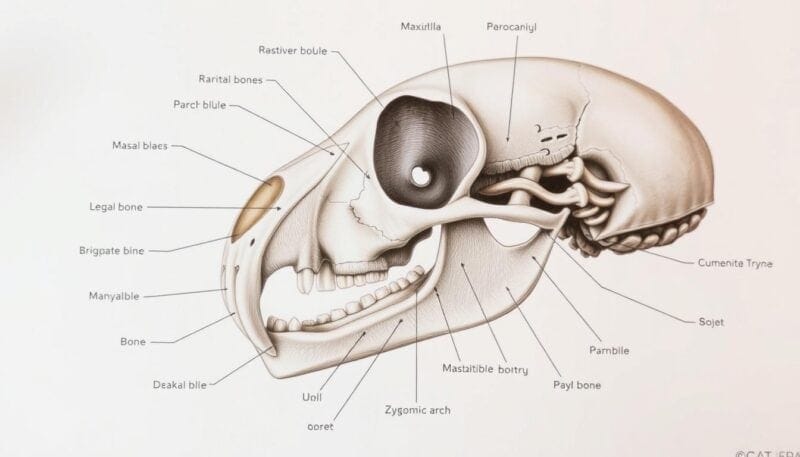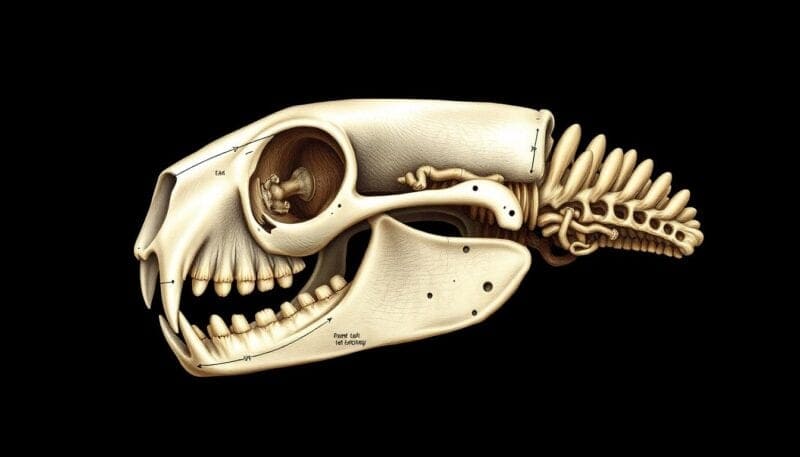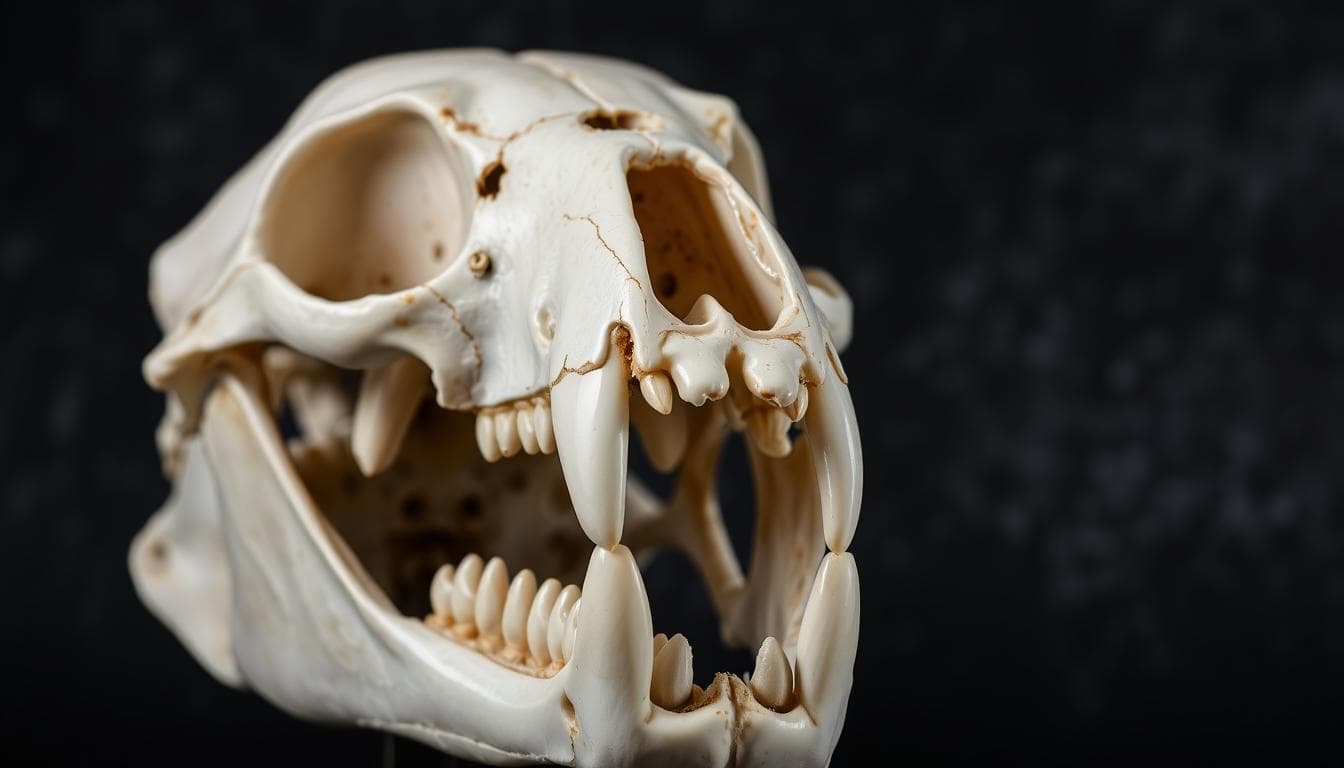Introduction
I’ve always been fascinated by cat anatomy. Their skulls are full of secrets. They show how cats evolved to be great hunters. This guide will explore the world of cat skulls, revealing interesting facts.
Cats are amazing, with their grace and agility. But what’s behind their striking features? Studying cat skulls shows how they adapted to be predators. Their powerful jaws and sharp senses make them expert hunters.
If you love cats or study biology, this article is for you. It will help you understand cat skulls better. Let’s explore their anatomy, evolution, and medical aspects together. Get ready to discover the wonders of the feline cranium!
- Introduction to Feline Cranial Anatomy
- The Unique Features of Cat Skulls
- Comparative Analysis: How Cat Skulls Differ from Other Mammals
- Major Components of Feline Cranial Structure
- The Role of Cat Skulls in Predatory Behavior
- Growth and Development of Cat Skulls
- Common Variations Among Different Cat Breeds
- Medical Implications and Health Considerations
- Preservation and Collection of Cat Skulls for Study
- FAQ:
- How do you identify a cat's skull?
- Are cats skulls strong?
- Can I keep a cat skull?
- Why does my cat have a ridge on his skull?
- Do all cats have the same skull?
- Why does my cat have a bump on his head?
- Why do cats flatten their head?
- What are the key features of cat skulls?
- How do cat skulls differ from other mammalian skulls?
- How do skull differences between cat breeds affect their health?
Introduction to Feline Cranial Anatomy
Exploring pet osteology, we find the fascinating details of feline cranial anatomy. This journey helps us understand the bone structures that make cat skulls unique. It shows us the importance of studying these structures.
Basic Structure and Function
The cat skull is a masterpiece of design. It has many bones that work together for important functions. The mandible helps with biting, and the nasal passages and sinuses are key for survival and adaptability.
By looking at the anatomy of these bones, we learn how cats evolved to be great hunters.
Evolutionary Significance
Millions of years of evolution have shaped cat skulls. As felines evolved, their skulls changed to fit their hunting lifestyle. Their sharp teeth, strong jaws, and keen senses make them skilled hunters.
Why Study Cat Skulls
Studying pet osteology, especially feline cranial anatomy, is very important. It helps in veterinary medicine, biological research, and understanding nature. By studying cat skulls, scientists and vets can learn about their health, behavior, and evolution.
This knowledge helps us care for our pets better and appreciate their unique nature.
| Bone Structure | Function | Evolutionary Significance |
|---|---|---|
| Mandible | Powerful biting and chewing | Adaptation for predatory behavior |
| Nasal Passages | Enhanced sense of smell | Improved prey detection and tracking |
| Cranial Sinuses | Airflow regulation and temperature control | Adaptation to various environmental conditions |
The Unique Features of Cat Skulls
The feline cranium, or skull, has many special features. These set it apart from other mammals. They help cats sense their surroundings, hunt, and survive in the wild. Exploring cat specimens in natural history collections reveals amazing adaptations that have developed over time.
Cats have sharp, powerful teeth for tearing prey. Their canine teeth are long and curved, perfect for catching and holding onto animals. This tooth structure, along with their strong jaws, allows them to bite with great force. This is key for their hunting lifestyle.
Cats also have a highly developed sense of smell. Their nasal cavity and turbinate bones make their sense of smell very sharp. This helps them track prey, mark territory, and move through their environment.
- Powerful, sharp-edged teeth for tearing and consuming prey
- Elongated, curved canine teeth serving as formidable weapons
- Highly sensitive olfactory system with complex turbinate bones
- Specialized adaptations for hunting and sensory perception
| Feature | Function |
|---|---|
| Enlarged auditory bullae | Improved hearing for detecting prey and predators |
| Flexible, articulated jaw joint | Allows for a wide range of motion and powerful biting |
| Retractable claws | Enables silent stalking and efficient climbing |
These special features of the feline cranium come from long evolutionary changes. They help cats succeed as predators in many different places. By looking at the skeletal anatomy of these animals, we learn a lot about their history and how they survive.
Comparative Analysis: How Cat Skulls Differ from Other Mammals
Understanding cat skulls is key in comparative anatomy. They show clear differences from canine and human skulls. These insights help us see how cats evolved and hunt.
Differences from Canine Skulls
Cat and dog skulls look very different. Cat skulls are rounder and more streamlined. Dog skulls are longer and more angular. This shape helps cats bite and tear prey effectively.
Comparison with Human Skulls
Cat skulls have distinct features compared to humans. Cats have bigger eyes and a stronger muzzle. These traits improve their vision and smell, aiding in hunting. Their teeth are also made for tearing, unlike humans.
Unique Predatory Adaptations
- Powerful, flexible jaws with sharp teeth for tearing and consuming prey
- Enlarged eye sockets and enhanced binocular vision for tracking and stalking prey
- Elongated muzzle and specialized olfactory system for detecting prey scents
- Compact, agile skull structure that supports rapid movements and pouncing behavior
These adaptations in cat skulls have evolved over millions of years. They make cats efficient hunters in various environments.
| Feature | Cat Skull | Canine Skull | Human Skull |
|---|---|---|---|
| Jaw Shape | Rounded, streamlined | Elongated, angular | Balanced, less pronounced |
| Eye Sockets | Enlarged for binocular vision | Moderate size | Smaller, more recessed |
| Muzzle Length | Elongated for olfactory senses | Elongated for olfactory senses | Shorter, less pronounced |
| Dentition | Sharp, specialized for tearing | Varied, including crushing molars | Generalized, less specialized |
This analysis shows how cat skulls are uniquely adapted for hunting. It’s important for studying veterinary specimens and teaching anatomy. It helps us understand the differences in anatomy between species.
Major Components of Feline Cranial Structure
Exploring the bone structures of a cat’s pet osteology reveals key parts of its skull. The cranium, facial bones, and powerful jaws all play important roles. Each part is crucial for the cat’s function and survival.
The Cranium
The cranium, or braincase, protects the cat’s brain. It’s made of several bones fused together. This strong, rounded skull supports the cat’s senses and hunting skills.
Facial Bones
The cat’s facial bones surround the cranium. They include the nasal, maxillary, and mandibular bones. These bones shape the cat’s face, enhancing its sense of smell and hunting prowess.
The Jaw Structure
The cat’s jaws are central to its skeletal anatomy. Composed of the maxillary and mandibular bones, they are incredibly strong. This strength allows cats to efficiently catch and eat their prey.
| Cranial Component | Function |
|---|---|
| Cranium | Protects the brain, provides a sturdy foundation for the senses and predatory abilities |
| Facial Bones | Form the distinctive features of the feline face, contribute to acute sense of smell and efficient hunting |
| Jaw Structure | Powerful, articulated jaws enable cats to grip, tear, and consume prey with remarkable efficiency |
Understanding a cat’s skull is key to appreciating its hunting prowess. By examining its bone structures, pet osteology, and skeletal anatomy, we learn about its remarkable abilities.

The Role of Cat Skulls in Predatory Behavior
The cat’s skull is key to its hunting skills. It’s a topic of interest for those who study veterinary medicine and comparative anatomy. Let’s explore how the cat’s skull helps it hunt and succeed.
Jaw Mechanics: Precision and Power
A cat’s jaw is designed for precision and power. Its skull has a special joint called the carnassial. This joint lets their jaws exert a lot of force while staying agile.
This, along with sharp teeth and a compact skull, makes cats great hunters.
Bite Force Analysis: Formidable Hunters
Research shows that cats are incredibly strong hunters. Big cats like tigers and lions can bite with over 1,000 psi. Even smaller cats have a bite force of 100 to 200 psi.
This strength lets them quickly kill and eat their prey, tearing through tough skin and bone.
Hunting Adaptations: Refined for the Chase
The cat’s skull is made for hunting. Its forward-facing eyes and powerful jaws help it catch prey efficiently. These features, developed over millions of years, show how amazing cat skulls are.
Growth and Development of Cat Skulls
Learning about cat skulls is key for pet osteology and anatomical education. Kittens grow into adult cats, and their bones change a lot. These changes show how they grow physically and develop.
From the start, a cat’s skull grows a lot. Newborn kittens have big heads for their body size. But as they get older, their skull gets more in line with their body. Genetics, food, and environment play big roles in this growth.
When kittens are young, their skull bones are not yet fixed. This lets their brain and face grow. Later, the bones fuse, making the skull stronger. This is important for protecting the brain and senses.
The shape of a cat’s skull also changes. Some cats, like Persians and Himalayans, have round faces. Others have longer, more pointed faces. These looks come from breeding and genetics.
Studying cat skulls helps us learn more about pet osteology and anatomical education. It shows how cats grow and adapt. This knowledge helps us understand these amazing animals better.
Common Variations Among Different Cat Breeds
The world of cat skulls is full of diversity. Each breed, from brachycephalic to oriental and standard domestic cats, has its own unique skull. These differences help us understand how selective breeding and evolution shape cat skulls.
Brachycephalic Breeds
Brachycephalic cats, like Persians and Exotic Shorthairs, have short faces and round foreheads. These features are appealing but can cause health problems. Studying their skulls helps vets and researchers find ways to improve their health.
Oriental Breeds
Oriental cats, such as Siamese and Balinese, have long, wedge-shaped skulls. Their distinctive shape is the consequence of breeding selectively. Looking at their skulls can teach us about their evolution and health.
Standard Domestic Cats
Standard domestic cats, often called “mixed” or “non-pedigreed,” have balanced skulls. They are closer to the natural feline form. Studying their skulls helps us understand the natural anatomy of cats.
Exploring cat breed variations shows us the amazing diversity of feline skulls. Whether it’s the short faces of brachycephalic cats, the long skulls of oriental breeds, or the balanced skulls of standard domestic cats, studying cat skulls is fascinating.
Medical Implications and Health Considerations
Looking into cat skulls is key in veterinary medicine and teaching anatomy. It helps us understand the special features of cat skulls. This knowledge is vital for spotting and treating health issues in cats.
Examining veterinary specimens is crucial for diagnosing diseases. Knowing the cat skull’s anatomy helps vets read X-rays better. They can then spot problems like congenital deformities, traumatic injuries, and dental issues and plan the right treatment.
Studying pet osteology is also important for anatomical education. It teaches future vets about cat skull features. This knowledge helps them make better diagnoses and treatments.
| Medical Condition | Diagnostic Approach | Treatment Considerations |
|---|---|---|
| Congenital Deformities | Radiographic Imaging | Surgical Intervention, Supportive Care |
| Traumatic Injuries | Computed Tomography (CT) Scans | Fracture Repair, Stabilization, Pain Management |
| Dental Issues | Dental Radiography | Tooth Extraction, Periodontal Treatment, Dental Cleaning |
By studying cat skulls, vets and students can better understand feline anatomy. This leads to more accurate diagnoses and better care for cats.

“Understanding the intricate anatomy of the cat skull is essential for providing comprehensive veterinary care and advancing the field of comparative anatomy.”
Preservation and Collection of Cat Skulls for Study
Keeping and collecting cat skulls is key for science and learning. By cleaning and storing them right, you help us understand cats better. This includes their skull shape, how they evolved, and their behavior.
Cleaning Methods
First, you need to clean the cat skulls well. This means removing any leftover meat, fur, or tissue carefully. Use tools like forceps and scalpels, and chemicals like degreasing agents for a clean finish.
Storage Techniques
After cleaning, it’s important to store the skulls right. Use acid-free containers like special boxes or cabinets. Also, keep the temperature and humidity just right. This keeps the skulls in good shape for studying, displays, and research.
FAQ:
How do you identify a cat’s skull?
To identify cat skulls, look for their distinct features: a rounded cranium, large eye sockets, and a short, tapered jaw. The sagittal crest, a ridge along the top, is prominent in some cats, aiding muscle attachment. These traits reflect the feline’s predatory adaptations and distinguish their skulls from other animals.
Are cats skulls strong?
Cat skulls are remarkably strong and designed to protect vital organs like the brain while maintaining a lightweight structure. Their rounded shape offers durability and resistance to impacts, aiding survival during falls or confrontations. This balance of strength and flexibility reflects the evolutionary adaptation of felines to their predatory lifestyles.
Can I keep a cat skull?
Keeping cat skulls is legal in many areas, provided they are obtained ethically and comply with local wildlife and animal preservation laws. They can serve educational or artistic purposes, showcasing the intricate anatomy of felines. Always ensure proper cleaning and handling to preserve the skull and respect the animal’s legacy.
Why does my cat have a ridge on his skull?
The ridge on your cat’s skull is likely part of the natural structure of cat skulls, particularly the sagittal crest, which provides attachment points for jaw muscles. This feature is more prominent in some cats and aids in their ability to chew and hunt efficiently. If abnormal, consult a veterinarian.
Do all cats have the same skull?
Not all cat skulls are the same; variations exist between breeds due to selective breeding. For instance, brachycephalic breeds like Persians have shorter, flatter skulls, while domestic cats typically have elongated skulls. These differences impact facial structure, breathing, and even behavior, highlighting the diversity within feline anatomy and evolution.
Why does my cat have a bump on his head?
A bump on your cat’s head could result from an injury, infection, or benign growth such as a cyst. Understanding the anatomy of cat skulls helps identify abnormalities. While some bumps are harmless, others may require veterinary attention to rule out abscesses or tumors and ensure your cat’s overall health.
Why do cats flatten their head?
Cats flatten their heads as a defensive behavior when they feel threatened. This posture minimizes exposure of vulnerable areas, leveraging the structure of cat skulls to protect vital parts. It’s often accompanied by hissing or crouching, signaling fear or aggression, and is a natural response to perceived danger or stress.
What are the key features of cat skulls?
Cat skulls are unique, with a rounded cranium and large eye sockets. They also have powerful jaws for hunting and tearing prey. These features show how cats are built for hunting and sensing their surroundings.
How do cat skulls differ from other mammalian skulls?
Cat skulls are more rounded than canine skulls, with bigger eye sockets and sharp teeth. They are different from human skulls, which are adapted for speech and other human needs.
How do skull differences between cat breeds affect their health?
Short, flat faces in brachycephalic breeds like Persians can cause breathing problems. In contrast, longer faces in oriental breeds are less likely to have these issues.
Share your thoughts in the comments below! If you enjoyed this post, consider subscribing to our newsletter for more pet tips, stories and blogs!

